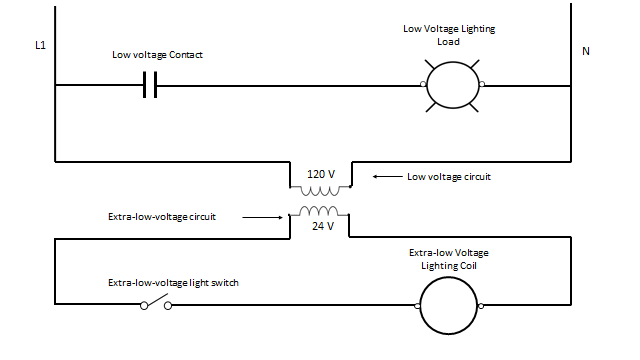44 Extra-Low-voltage switch relays
Aaron Lee
The Canadian Electrical Code defines a circuit that operates at 30 volts or less as extra-low voltage, while household voltages of 120 volts are defined as low-voltage. Outside of these technical definitions, in common parlance people may refer to these different voltages as “low-voltage” (30V and less) and “line-voltage” (120V or higher). Care must be taken to avoid confusion when using these terms.
Low voltage switching relays utilize an extra-low-voltage circuit to control low-voltage lighting loads.
For example, a large commercial installation may have many rows of fluorescent lighting energized at 347 volts that would be impractical to control from a single location due to the large amounts of current that would be drawn by the lamp loads.
Instead of controlling the lighting load directly with a switch, as with simple 120V lighting circuits, we instead use the extra-low-voltage switch to energize a contactor. The contactor is a solenoid relay that, when energized by the extra-low-voltage circuit, will close a set of contacts and energize the lamp loads.

There are numerous advantages of using this style of switching system, such as installing smaller and cheaper switches. Extra-low-voltage wires can be easily installed and run to various locations cheaply and safely.
The contactors which actually control the lights are powered by the extra-low-voltage circuit, and so care must be taken to ensure that when all the contactors are energized they do not overload the circuit. To help reduce the load demand of the contactors, many come as “latching” style contactors, meaning that they only need a brief signal to engage, or close their contacts. Once the solenoid has pulled in, a latch prevents it from releasing. A second signal must be sent to the relay to “unlatch” or de-energize the lighting load.
There must be a physical separation or barrier between the extra-low-voltage control circuit components and the low-voltage lighting circuit.
